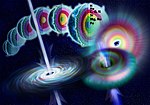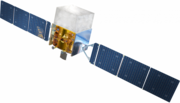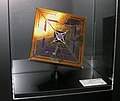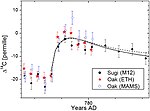In gamma-ray astronomy, gamma-ray bursts (GRBs) are immensely energetic explosions that have been observed in distant galaxies, being the brightest and...
116 KB (12,670 words) - 04:19, 22 May 2024
Gamma-ray burst progenitors are the types of celestial objects that can emit gamma-ray bursts (GRBs). GRBs show an extraordinary degree of diversity....
20 KB (2,862 words) - 01:20, 5 February 2023
Neil Gehrels Swift Observatory (redirect from Swift Gamma Ray Burst Explorer)
Swift Gamma-Ray Burst Explorer, is a NASA three-telescope space observatory for studying gamma-ray bursts (GRBs) and monitoring the afterglow in X-ray, and...
34 KB (4,090 words) - 23:44, 16 May 2024
A soft gamma repeater (SGR) is an astronomical object which emits large bursts of gamma-rays and X-rays at irregular intervals. It is conjectured that...
7 KB (622 words) - 19:41, 5 April 2024
The following is a list of significant gamma-ray bursts (GRBs) listed in chronological order. GRBs are named after the date on which they were detected:...
33 KB (2,032 words) - 04:09, 24 May 2024
instrument aboard Fermi, the Gamma-ray Burst Monitor (GBM; formerly GLAST Burst Monitor), is being used to study gamma-ray bursts and solar flares. Fermi,...
55 KB (5,608 words) - 21:02, 7 April 2024
A gamma ray, also known as gamma radiation (symbol γ ), is a penetrating form of electromagnetic radiation arising from the radioactive decay of atomic...
58 KB (7,126 words) - 18:04, 23 May 2024
GRB 221009A (category Gamma-ray bursts)
gamma-ray burst (GRB) jointly discovered by the Neil Gehrels Swift Observatory and the Fermi Gamma-ray Space Telescope on October 9, 2022. The gamma-ray...
47 KB (4,536 words) - 01:12, 28 May 2024
Gamma-ray astronomy is a subfield of astronomy where scientists observe and study celestial objects and phenomena in outer space which emit cosmic electromagnetic...
28 KB (3,296 words) - 17:23, 23 May 2024
A terrestrial gamma-ray flash (TGF), also known as dark lightning, is a burst of gamma rays produced in Earth's atmosphere. TGFs have been recorded to...
28 KB (2,805 words) - 19:57, 14 April 2024
(launched 2002), NASA's Swift Gamma-Ray Burst Mission (launched 2004), ASI AGILE (satellite) (launched 2007) and NASA's Fermi Gamma-ray Space Telescope (launched...
20 KB (2,049 words) - 18:10, 17 May 2024
IKAROS (redirect from Gamma-ray Burst Polarimeter)
variation in dust density while its Gamma-Ray Burst Polarimeter (GAP) measured the polarization of gamma-ray bursts during its six-month cruise. IKAROS...
26 KB (2,416 words) - 00:27, 3 March 2024
effects of a galactic gamma-ray burst. A gamma-ray burst could also explain the rapid expansion of glaciers, since the high energy rays would cause ozone...
100 KB (10,835 words) - 23:36, 25 May 2024
location of a second repeating burst, FRB 180916. One FRB seems to have been in the same location as a known gamma-ray burst. On 28 April 2020, a pair of...
151 KB (14,608 words) - 10:47, 25 May 2024
GRB 970228 (category Long-duration gamma-ray bursts)
GRB 970228 was the first gamma-ray burst (GRB) for which an afterglow was observed. It was detected on 28 February 1997 at 02:58 UTC. Since 1993, physicists...
24 KB (2,534 words) - 11:38, 10 September 2023
GRB 090423 (category Long-duration gamma-ray bursts)
GRB 090423 was a gamma-ray burst (GRB) detected by the Swift Gamma-Ray Burst Mission on April 23, 2009, at 07:55:19 UTC whose afterglow was detected in...
19 KB (1,794 words) - 13:32, 21 May 2024
A gamma-ray precursor is a short X-ray outburst event that comes before the main outburst of the gamma-ray burst progenitor. There is no consensus on the...
6 KB (714 words) - 10:38, 6 January 2024
The history of gamma-ray began with the serendipitous detection of a gamma-ray burst (GRB) on July 2, 1967, by the U.S. Vela satellites. After these satellites...
30 KB (4,043 words) - 00:17, 21 July 2023
GRB 060614 (category Gamma-ray bursts)
GRB 060614 was a gamma-ray burst detected by the Neil Gehrels Swift Observatory on June 14, 2006, with peculiar properties. It challenged a previously...
4 KB (364 words) - 17:58, 16 May 2024
GRB 991216, nicknamed the Beethoven Burst by Dr. Brad Schaefer of Yale University, was a gamma-ray burst observed on December 16, 1999, coinciding with...
4 KB (459 words) - 11:24, 27 October 2023
The Gamma-Ray Burst Optical/Near-Infrared Detector (GROND) is an imaging instrument used to investigate Gamma-Ray Burst afterglows and for doing follow-up...
4 KB (404 words) - 20:48, 28 February 2024
General Coordinates Network (redirect from Gamma ray burst coordinates network)
The General Coordinates Network (GCN), formerly known as the Gamma-ray burst Coordinates Network, is an open-source platform created by NASA to receive...
7 KB (767 words) - 23:28, 28 September 2023
star and a black hole merge. These mergers are thought to produce gamma-ray bursts and emit bright electromagnetic radiation, called "kilonovae", due...
22 KB (2,193 words) - 13:01, 25 May 2024
Supernova (section Cosmic rays)
long-duration gamma-ray bursts. If the relativistic jets are too brief and fail to penetrate the stellar envelope then a low-luminosity gamma-ray burst may be...
199 KB (21,759 words) - 18:07, 27 May 2024
774–775 carbon-14 spike (redirect from 774–775 radiation burst)
perhaps the strongest known. Another proposed origin, involving a gamma-ray burst, is regarded as unlikely, because the event was also observed in isotopes...
15 KB (1,623 words) - 03:29, 11 May 2024
relativistic electromagnetic and massive vector field effects with gamma-ray burst production". Physical Review D. 96 (10): 104003. arXiv:1603.01464....
125 KB (8,596 words) - 23:34, 27 May 2024
orbiting satellites detect an average of about one gamma-ray burst per day. Because gamma-ray bursts are visible to distances encompassing most of the...
19 KB (2,404 words) - 03:03, 24 May 2024
GRB 080319B (redirect from Naked eye burst)
as the Clarke event) was a gamma-ray burst (GRB) detected by the Swift satellite at 06:12 UTC on March 19, 2008. The burst set a new record for the farthest...
11 KB (1,064 words) - 20:06, 17 April 2024
Sun. Gamma ray bursts are fairly rare, occurring only a few times in a given galaxy per million years. It has been suggested that a gamma ray burst caused...
145 KB (14,828 words) - 09:50, 25 May 2024
GRB 080916C (category Long-duration gamma-ray bursts)
080916C is a gamma-ray burst (GRB) that was recorded on September 16, 2008, in the Carina constellation and detected by NASA's Fermi Gamma-ray Space Telescope...
6 KB (608 words) - 00:04, 20 May 2024
























